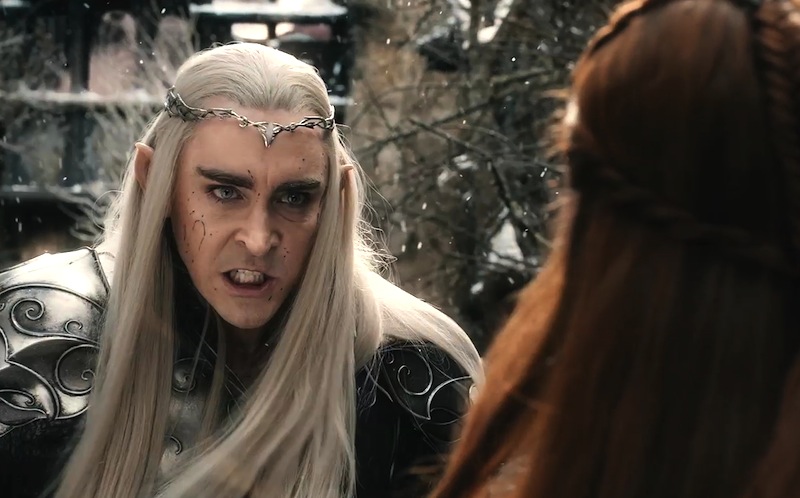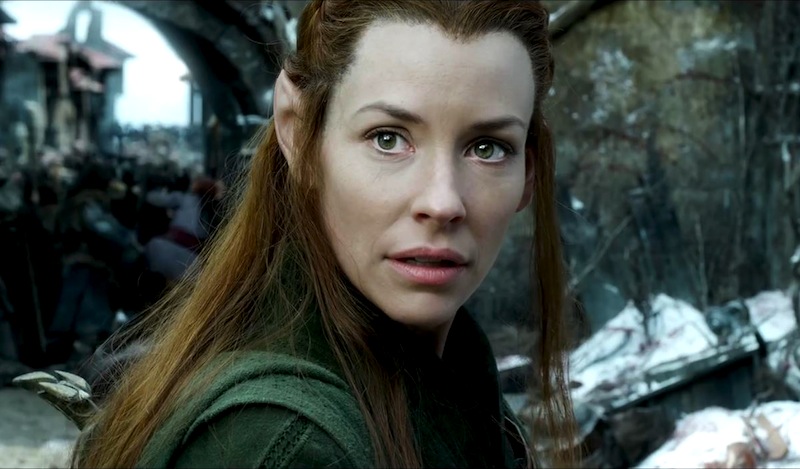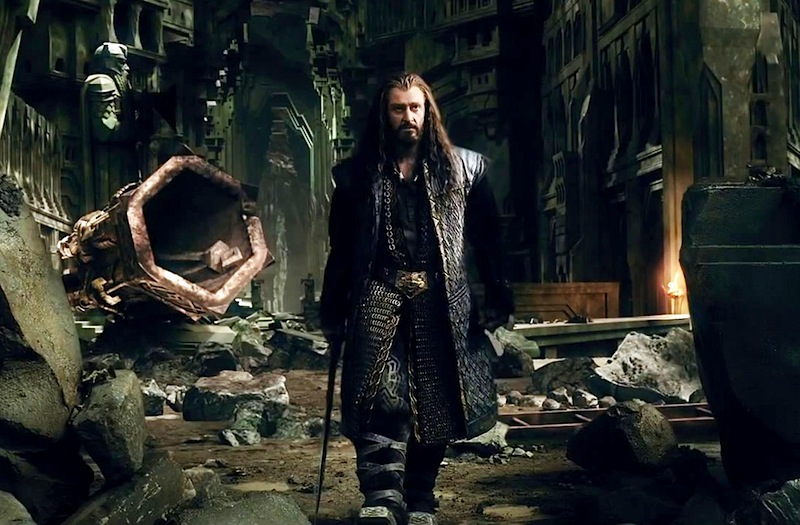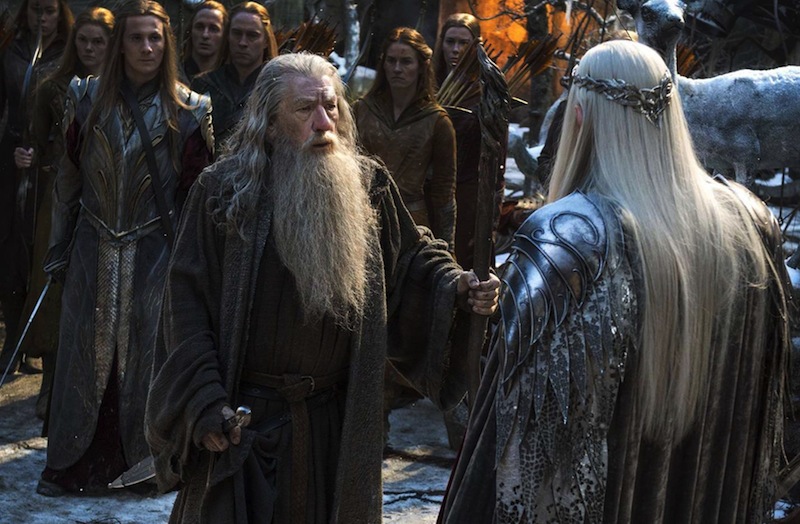It was a cue that the overall tone of the final Hobbit film had been altered when it’s subtitle was changed from There and Back Again to The Battle of the Five Armies. And while the film has its fair share of dazzling moments, it does prove what many fans had bemoaned from the very start of this enterprise: it should have been two films, not three.
Minor spoilers for the film (and book) below.

First thing’s first—the over-expansion of these films leads to one of their greatest missteps in the very first fifteen minutes. It is basically a reverse of the situation in the Lord of the Rings trilogy; in the books, Boromir dies at the start of The Two Towers, but for a film, that resonance isn’t going to play at the very start of a new film. Here, the opposite decision is made regarding Smaug’s attack, and the cognitive dissonance it causes is acute. Wait, who is that dragon again? Where were we when the last film ended? What are we concerned about? You remember Bard the Bowman, right kids? When all three films are available to marathon it won’t be so noticeable, but to jump right in on the action with exactly zero setup is a mistake that should have been reconsidered back when the second movie was released.
That said, it’s bothersome to hear people claim that Peter Jackson has “George Lucas’d” his films because he has proven himself to be a far more conscientious filmmaker in the long run. When the outcry over the 48 frames-per-second release occurred on the first Hobbit movie, Jackson went out of his way to make certain that the next two films looked better at 48fps. It’s most evident in the final installment; the higher frame rate is seamlessly integrated this time around, providing a more immersive sense to the world, but never distracting. Frame rate aside, it’s been hinted in several places that the studio stepped in far more often on these films than they did in LOTR—even the opening is jarring in this film, with the Warner Brothers logo displayed more prominently than it ever was before.

The studio’s interference is particularly glaring in the case of Tauriel’s love triangle with Kili and Legolas, something that the actress actively negotiated against in these films. It’s depressing to watch these scenes pan out because they distract from the core narrative in the worst possible way, making Tauriel’s addition to the world far less welcome than it might have been. Her function in the story as a foil to King Thranduil’s arrogance and distance was an excellent way of weaving a new female presence into the story—if only she weren’t constantly waylaid by emotions that she was literally given all of ten minutes to develop. You can almost see her railing against the higher-up mandate in several of these scenes. Both she and Orlando Bloom appear intent on bucking the studio’s influence by flat-out refusing to have chemistry, but that only makes their scenes together seem outright superfluous (because they are).
Even though the film is two-and-a-half hours long, we get surprisingly little of the core band. It is right for Jackson to put the primary focus on Thorin in these (too few) scenes, and he does, but the rest of the dwarves—who started out in An Unexpected Journey with much clearer characters and voices—all get lost as a result, with the exception of Balin and Dwalin. And sort of Kili. When Thorin does get his due, we see what was intended by this telling all along—Jackson’s desire to give the dwarven king and his band some degree of dignity and empathy, rather than making them out as haughty misers.

The addition of items from the Silmarillion and the LOTR appendices to the Hobbit’s plot line have been the cause of a great deal of controversy, and while these additions were fairly well assimilated into the narrative in the previous films, it basically falls apart here. There’s simply too much information; less active Tolkien fans are likely to get lost in these proceedings because there aren’t enough through lines to tie all these disparate pieces together. We see Sauron get driven from Dol Guldur (and Galadriel is spectacular to that effect), but that isn’t as tied in to the orc armies as it needs to be. Azog—the big bad papa orc for this entire trilogy—is far too important still, and it confuses the issue of who’s truly in charge here, him or Sauron?
When the film does what it is supposed to do, and focuses on the relationships between Bilbo and Thorin, Bilbo and Gandalf, Thorin and his kin, Bard and his family, even Tauriel and Legolas and Thranduil, the movie utterly shines. It’s a comfort in some ways, but it also throws the film’s issues into sharp relief. There is a lot of great material here and it doesn’t get anywhere near the focus is deserves. With so many puzzle pieces, it reads like an extended edition already (and Jackson has announced that he still has 30 minutes of additional footage to tack on), and the result is a sloppiness that could have easily been avoided.
It’s too bad that there are so many plots to put attention on because the actual Battle of the Five Armies gets less attention than it needs. It’s particularly heartbreaking because these sort of battle scenes are one of Jackson’s forte, and all the usual emotional punches that he layers into them are present… only to get waylaid by several other arcs that need resolving. It really does feel like the studio wanted more for their money, and just pushed for as many toppings on the hamburger that they could possibly achieve. The end result isn’t edible, but at least the execs feel like they got what they paid for.

There are a some very strange additions to Middle-earth on this go-around that feel entirely gratuitous, particularly when the fifth and final army arrives on the scene. They are creature-y and odd and require much more explanation that they’re given. (Guillermo del Toro helped with these scripts and these really do read like his sort of additions, so one has to wonder…) In addition, the appearance of Thorin’s cousin Dain is entirely jarring because—for some inexplicable reason—he is rendered entirely in CGI. Which is uncanny in the extreme and causes all of his scenes to be filmed at odd angles, as though they were trying to hide it. I assume there was an actual reason for this decision, but it had unfortunate results.
Certain additions to Tolkien’s story are bound to divide the hardcore fans, but they are still fun to consider here. For example, the question of Legolas’ maternity gets addressed, and for my part, I enjoyed the background given. Jackson also grandfathers in certain aspects of his LOTR films, and it’s pretty great—he gives reason for the Aragorn-Legolas buddy-buddy situation in those movies, something that never actually occurred in the books, but remains one of fandom’s favorite aspects of the films. A prominent death on screen also mirrors Boromir’s farewell with excellent parallels in both dialogue and visuals. So there are touches here and there, places where everything feels cohesive. Instead of extended editions, perhaps Jackson could go the opposite route and shave The Hobbit down to two films, as he originally intended. I’d watch that director’s cut in a hot second.

So it’s a bittersweet farewell, but it was fun all the same. With any luck, the full Middle-earth marathons will make everything flow together, and either way, it’s a journey that I was happy to take.
Emmet Asher-Perrin still cried a lot during the battle scenes and death scenes, and scenes that alluded to the battle scenes and death scenes. You can bug her on Twitter and Tumblr. Read more of her work here and elsewhere.










